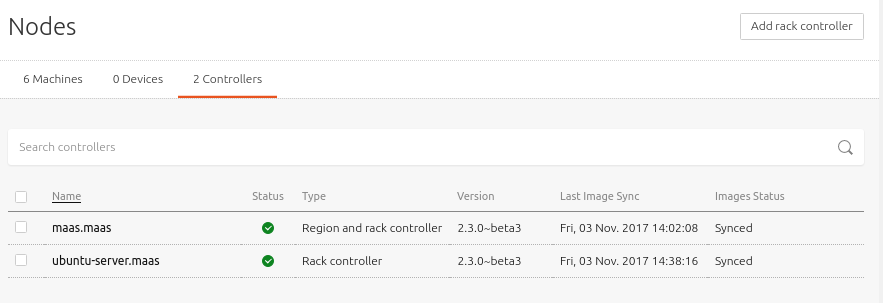Rack Controller
A rack controller can be connected to multiple VLANs, each from a different network interface. This provides a scaling factor that can help as a network architecture grows in size.
In regards to region controller and rack controller communication, each rack controller must be able to initiate TCP connections:
- for HTTP, to each region controller on port 5240. If high availability is implemented then this will typically become port 80. See MAAS HA.
- for RPC, to each region controller between port 5250 and 5259 inclusive. This
permits up to 10
maas-regiondprocesses on each region controller host. At present this is not configurable.
Install a rack controller
Installing a rack controller consists of installing the rack controller software and then registering the rack controller with the region API server.
When a rack controller is installed on the same host as the region API server registration occurs automatically. This can occur by installing a complete environment on a single host in one of two ways:
- Using the Ubuntu Server ISO (see Install from ISO)
- Using Ubuntu packages: either the 'maas' metapackage or multiple individual packages (see Install from packages)
A rack controller can be installed on a host devoid of a region API server, and registered manually, in one of two ways:
- Using the Ubuntu Server ISO (see Install from ISO)
- Using the 'maas-rack-controller' Ubuntu package (see MAAS CLI - advanced tasks)
Once registered, if this is an extra rack controller, it will appear immediately alongside the primary controller in the web UI and begin to sync with it:

See MAAS CLI - advanced tasks for how to list (and confirm) all registered rack controllers with the CLI.
Multiple rack controllers are needed in order to achieve specific types of high availability. See MAAS HA.
Note: If you will be using KVM-backed nodes you must ensure that the new rack controller can communicate with the KVM host. See KVM guest nodes.
Unregister a rack controller
If you ever want to unregister a rack controller, which is probably something you would only do to an extra one you may have added, you will need to delete it from the region API server; there is no 'unregister' command.
To do so, navigate to the 'Nodes' page and then the 'Controller' tab. Enter the controller's page by clicking on the machine you want to delete and select 'Delete' from the dropdown (and then 'Go'). MAAS will do the right thing if the controller was used for DHCP HA (i.e. DHCP HA will no longer be enabled since there is no longer the possibility of having it).
Although similar, this is not conceptually equivalent to deleting a MAAS node. Here, you are deleting a machine that is a part of MAAS itself.
Note: Unless the software on this machine is removed, rebooting it will cause the machine to re-instate itself as a rack controller. This behaviour may change with future versions of MAAS.
